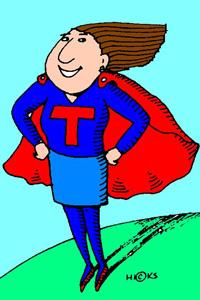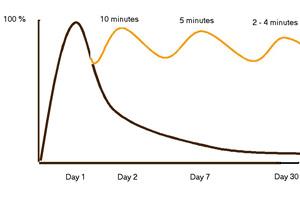How To Use Memory Tricks to Learn Languages

Tiziana is also the study center manager at Cambridge, and loves helping her students learn tricks to make their English learning easier.
I’ve been teaching for 15 years now, which makes about 12,000 hours of classes and thousands of students. I’ve now been teaching and working as a Structured Study Manager at Kaplan International Colleges in Cambridge for a year, a year full of events and wonderful people.
Some of my students and friends think I have superpowers: I am bilingual in English and Italian, and I can speak German, French, Spanish and Portuguese, and understand a bit of Swedish, too (try my Dutch, I think I am working it out!).
Everybody wants to know my secret. Do you?
My superpower is my (not so) SUPER MEMORY.

The good news… it’s not really a secret, and I am more than willing to share 2 of my tricks with you.
Trick No. 1: Use your senses and your imagination

Imagination plays a central role in learning. Imagination helps you associate words, sounds, spelling and meaning. Let me teach you some Samoan. Try to learn these words:
Toalua - husband
Tamaloa - man
tamaitiiti - child
taulealea - youth
loomatua - old woman
(Adapted from The Sunday Times)
What do you do when you see a list of words that you have never seen before and need to remember?
1. Use your ears – does it sound like a word in your language? Does it sound like something you an associate to the word and its meaning?
For example, I’m going to use Italian to remember this word - Toalua
TOA is similar to “tuo”, which in Italian means YOURS. LUA sounds like "lui", which in Italian means HIM. So YOUR HIM = your husband… DONE! I will remember it for longer than just one second.
Loomatua – it’s a looooong sound, it takes loooooong to say it, and it’s slow… like some old people.
Here is another example. The word “mergulhar” in Portuguese means “to dive”. I associate the gargling sound “lh” to the noise the water makes around my body and ears when I dive.
2. Use your body – what happens to your mouth, tongue and face when you say a word?
Tamaitiiti – what happens to your face and mouth when you say the sound /i:)/?
Your eyes get small, your mouth is closed and small… I associate the sound with something little, tiny… so Tamaitiiti, with so many /i:/, means children, because they are small.
Another non-Samoan example? Hungry and angry.
When you say “hungry”, blow the air goes out of your body, making your stomach nice and flat. Just like when you haven’t eaten for a while and you are hungry.
When you say “angry” your face twists and turns and your expression changes, making you look a bit angry.
The stranger the association, the easier it will be to remember the words.
3. Use your eyes – what is the shape of the word? Where did you read it?
I prefer to use my body (kinaesthetic learning) and ears (auditory learning), but you can use your eyes, too (visual learning): look at the shape of letters and associate it with the meaning of the word.
Like the word pebbles.

p e b b l e s
It is a round word, as almost every letter is round. Just like the pebbles on a beach.
Trick No. 2: Create connections
The more senses you use to associate to a particular word, the more likely you are to remember it. as you create more “roads” towards it, in your complex system of connections in your brain. It’s like animal tracks. If an animal keeps using the same route to go from one place to the other, it will leave a clear track in the forest and it will easily find it again (recalling). If that animal stops using it, the track will soon disappear under the growing vegetation (forgetting).
Revising (Studying)
However, if we do not repeatedly return our attention to these terms and definitions, we will forget about 40% over the first 24 hours (Point B). If we wait another 24 hours before reviewing the information, we have lost 60% (Point C). So we can go from a grade of ‘A’ (100%) to ‘D’ (60%), to ‘F’ (40%) in just 48 hours.

You can be as creative as you want with your associations, but if you do not revise, this is what will happen to the things you have learned.
Day 1, at the beginning of the lesson, you know 0%, at the end of the lecture you know 100% of what you know, however well you know it.
By Day 2, if you have done nothing with the information you learned (i.e. read it, thought about it, used it, etc), you will have lost a stunning 50%-80% of what you learned!!!
If you even just think about it for a few minutes, your memory will stay up where the yellow line is. As you cycle home, as you take your shower, as you sit on the bus, think about your lesson. That is all you need to do.
So… ready to use your superpower?
What is Tamaitiiti in Samoan?
